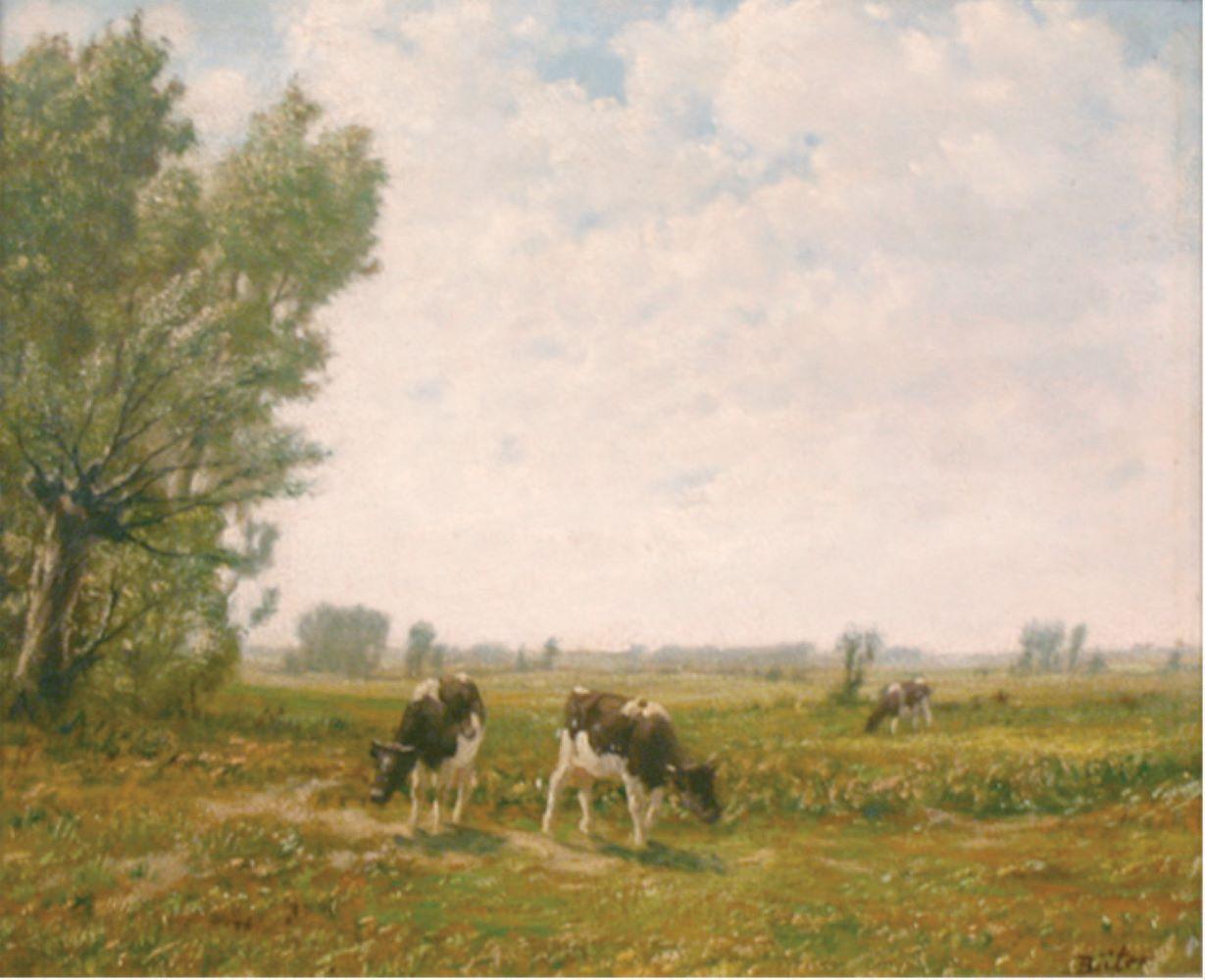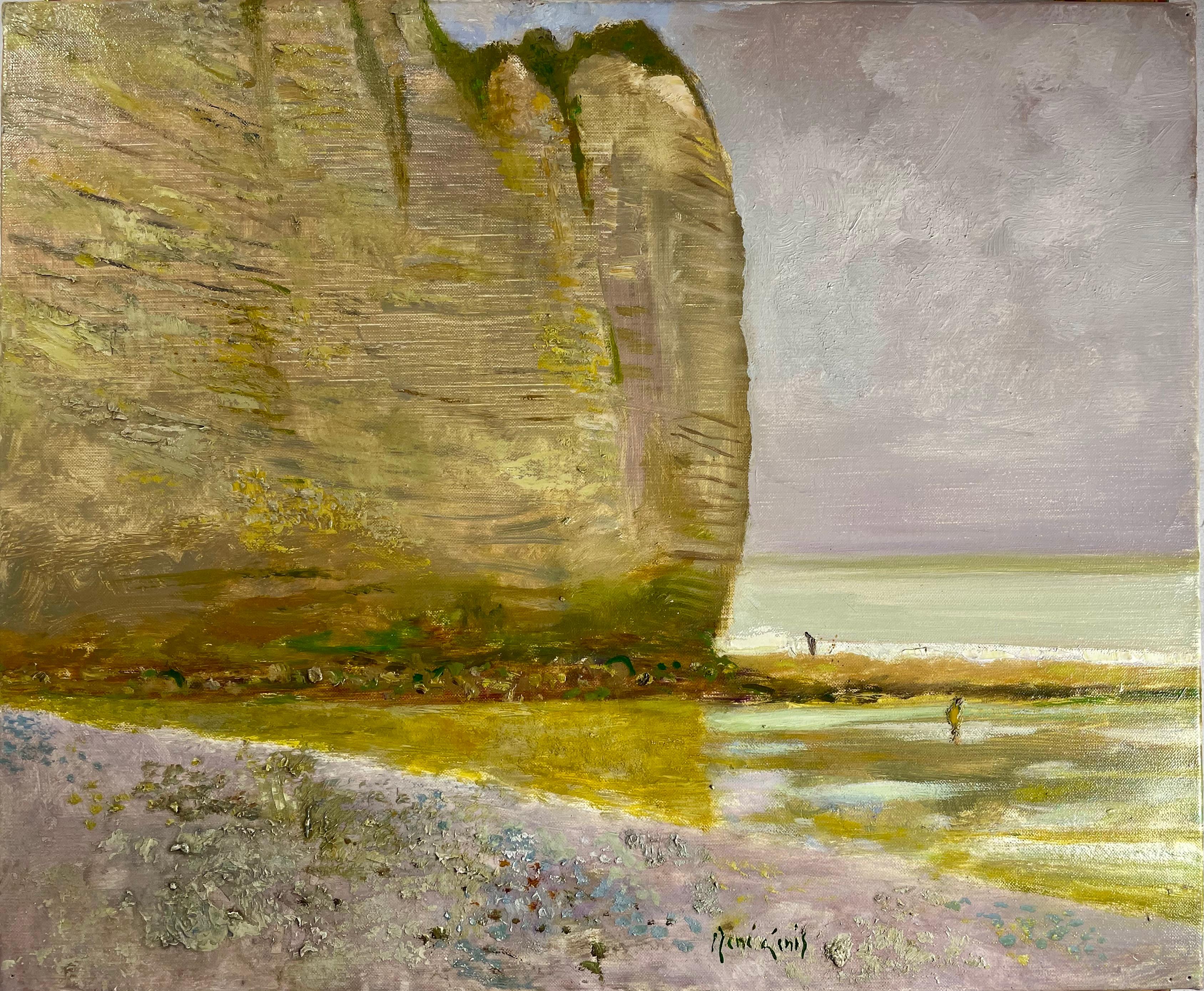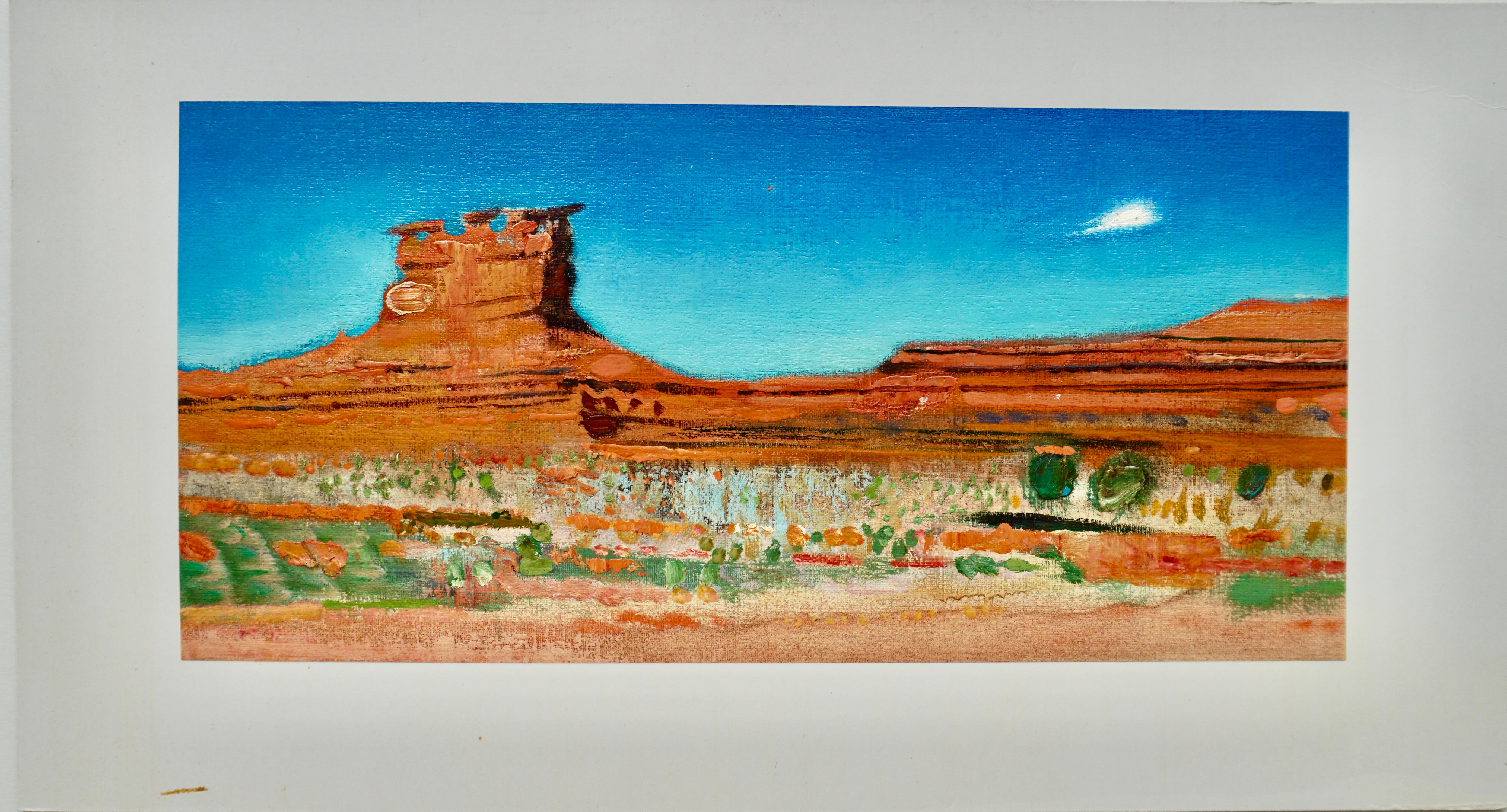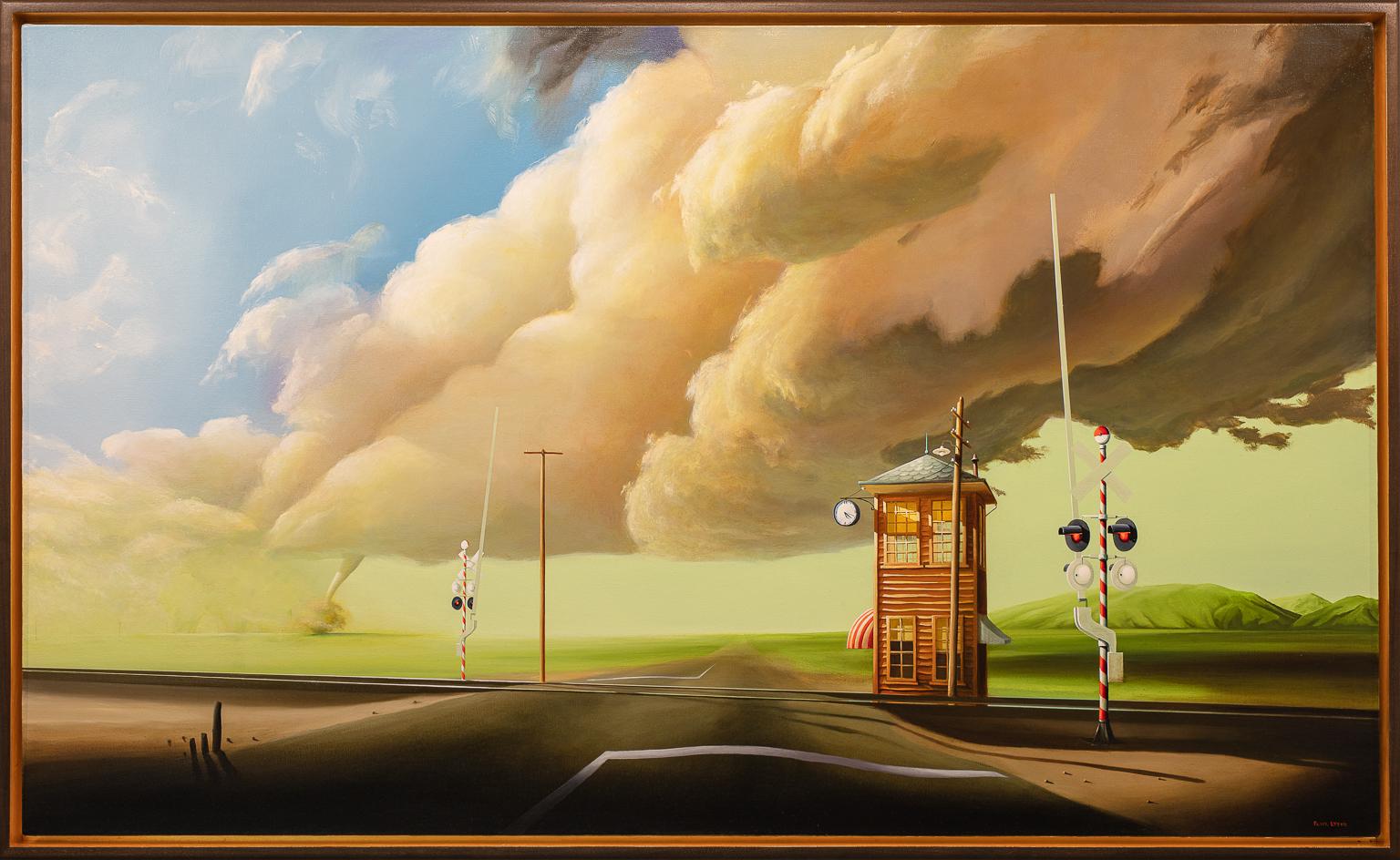Items Similar to Instow from Appledore, Oil Landscape, Signed and Dated 1938
Want more images or videos?
Request additional images or videos from the seller
1 of 5
Alfred Henry Robinson Thornton NEACInstow from Appledore, Oil Landscape, Signed and Dated 19381938
1938
About the Item
Oil on canvas, signed and dated '38' bottom right
Original title inscription and date 'Nov 19th 1838' verso
Image size: 30 x 24 inches (76 1/4 x 61 cm)
Contemporary style hand made frame
Provenance
City of Manchester Art Gallery (exhibition label on reverse)
New English Art Club (exhibition label on reverse)
City of Bradford Corporation Art Gallery (exhibition label on reverse)
This charming and peaceful scene provides a view of Instow, a village in North Devon England, from Appledore, another village that is situated on the other side of the estuary. Interestingly, in this composition that artist has chosen not to focus on the villages themseleves but gives pride of place instead to a series of pleasure boats that take up the lion's share of the pictorial space.
Alfred Henry Robinson Thornton
The son of a civil servant, Thornton was born in Delhi in 1963 and was educated in England where he graduated from Trinity College, Cambridge and served in the Foreign Office.
Soon deciding he wanted to pursue art, he studied at the Slade School from 1888 to 1889 and then the Westminster School of Art from 1888 to 1889, winning prizes for landscape painting. The artist also taught at Westminster School of Art as an assistant to Walter Sickert, 1893 - 94. He was elected a member of the NEAC in 1895 and acted as its Honorary Secretary from 1928. In 1928, he became the President of the influential Cheltenham Group, a society founded in 1920 to bring together local professional artists.
Thornton was most interested in impressionist and post-impressionist work and was inspired by the radicalism of French artists including Monet and Gauguin, the latter of whom he met in 1890. A prolific exhibitor, he showed frequently at the RA, NEAC, RBA, Goupil Gallery, Cooling Gallery, RSA, FAS and Redfern Gallery.
Thornton wrote 'The Diary of an Art Student of the Nineties', published the year before his death and which still remains a useful source of information on the various issues and factions that shaped the period. He was a member of the then influential Cheltenham Group, and a memorial exhibition was held at the Redfern Gallery in the year of his demise.
Examples of his work are in the collections Bradford Art Gallery, Manchester City Art Gallery, Leeds City Art Gallery, Leeds University Collection, Museums Sheffield, Victoria Art Gallery, Bath, BM, CAS, and at Tate Gallery, London.
- Creator:
- Creation Year:1938
- Dimensions:Height: 24 in (60.96 cm)Width: 30 in (76.2 cm)
- More Editions & Sizes:1 of 1Price: $2,111
- Medium:
- Period:
- Framing:Frame IncludedFraming Options Available
- Condition:
- Gallery Location:London, GB
- Reference Number:1stDibs: LU52413590632
About the Seller
5.0
Vetted Seller
These experienced sellers undergo a comprehensive evaluation by our team of in-house experts.
Established in 2007
1stDibs seller since 2014
63 sales on 1stDibs
Typical response time: 4 hours
- ShippingRetrieving quote...Ships From: London, United Kingdom
- Return PolicyA return for this item may be initiated within 14 days of delivery.
More From This SellerView All
- Back Gardens Original Oil Painting 20th Century Urban Landscape British ArtBy Alice Headley NeaveLocated in London, GBAlice Headley Neave 1903 - 1977 Back Gardens Oil on canvas, signed lower left Image size: 19 x 15 inches Contemporary style frame The daughter of Dr Arthur Henry Headley Huckle, Alice was...Category
20th Century Landscape Paintings
MaterialsCanvas, Oil
- Morning Drive in Hyde Park, 20th Century English Oil PaintingBy Doris ZinkeisenLocated in London, GBOil on canvas, signed lower right Image size: 28 3/4 x 28 3/4 inches (73 x 73 cm) Contemporary frame Doris Zinkeisen was a British painter, stage-set and costume designer, writer a...Category
Mid-20th Century English School Landscape Paintings
MaterialsCanvas, Oil
- The Artist at Work, 19th Century German Oil Landscape PaintingLocated in London, GBOil on canvas on board, signed lower left Image size: 12 1/4 x 19 inches (31 x 48.5 cm) Hand made gilt frame Johann Christian Kröner was the son of the decorative painter Johann Kröner (1788–1848) and his wife Clara Regina, née Meyer (1792–1862). Kröner attended high school in his hometown until 1852 and then worked for his brother, who had taken over the paternal painting business , as an apprentice. He also sketched outdoors to capture nature. It was only from 1861 that he could continue to devote himself to art. He first went to Munich and the artist colony in Brannenburg , where he painted landscapes and got to know local painters, including Carl Irmer , Wilhelm Busch , Julius Rollmann and Louis Hugo Becker . In 1863 he went to Düsseldorf, where he met the landscape painter Louis Hugo Becker, moving in the milieu of the Düsseldorf School. With his artist friends and paint box in hand, they worked from self-study and frequent trips to Upper Bavaria , Thuringia and particularly Westphalia. Among his circle of friends in Düsseldorf were Gustav Süs, Karl Bertling, Eduard Geselschap, Abert Baur, Eugen Dücker...Category
Late 19th Century Landscape Paintings
MaterialsCanvas, Oil
- The White Cross Inn, Richmond, New English Art Club Oil PaintingBy William Henry InnesLocated in London, GBOil on canvas, signed Image size: 20 x 24 inches Framed New English Art Club label to the back and his address for Herne Hill, LondonCategory
20th Century English School Landscape Paintings
MaterialsCanvas, Oil
- Island of Gibraltar, Oil 19th Century LandscapeLocated in London, GBOil on canvas Image size: 8 3/4 x 12 1/2 inches (22 1/4 x 31 3/4 cm) Gilt frame This is a painting from the 19th Century depicts Gibraltar Island in Ohio, America, located within la...Category
19th Century Victorian Landscape Paintings
MaterialsCanvas, Oil
- Notting Hill Gate Station from the Road, 20th Century Oil PaintingBy Edward McKnight KaufferLocated in London, GBOil on canvas board, signed lower left 'McKnight' Image size: 19 ½ x 14 ½ inches (49.5 x 37 cm) Contemporary frame Looking from the bridge we peer down the Notting Hill Gate Train S...Category
Early 20th Century Modern Landscape Paintings
MaterialsOil, Canvas
You May Also Like
- Bernhard ButerLocated in Saint Augustine, FLArtist: Bernhard Buter (1883-1959) German Title: Rhinish Landscape Medium: Oil on Canvas Dimensions: Framed 19” x 21” , Unframed 11 x 13” Bernhard Buter paints agrarian landscapes i...Category
Early 20th Century Realist Landscape Paintings
MaterialsCanvas, Oil
- "Les Falaise Normande" (The Cliffs Of Normand)By René GenisLocated in Berlin, MDRene Genis (French 1922-2004) “Les Falaise Normande” / The Cliffs of Normand. A sea scape with high cliffs, the beach, and two fishermen. The cliffs are in browns, tans and olives a...Category
1990s French School Landscape Paintings
MaterialsCanvas, Oil
- "Monument Valley"By René GenisLocated in Berlin, MDRene Genis (French 1922-2004) Monument Valley. 1967. Beautiful oranges, browns, greens against a turquoise blue sky. Oil on canvas, laid on mat. Si...Category
Mid-20th Century Landscape Paintings
MaterialsOil, Canvas
- Early oil depicting the Great Fire of LondonLocated in London, GBThe Great Fire of London in September 1666 was one of the greatest disasters in the city’s history. The City, with its wooden houses crowded together in narrow streets, was a natural fire risk, and predictions that London would burn down became a shocking reality. The fire began in a bakery in Pudding Lane, an area near the Thames teeming with warehouses and shops full of flammable materials, such as timber, oil, coal, pitch and turpentine. Inevitably the fire spread rapidly from this area into the City. Our painting depicts the impact of the fire on those who were caught in it and creates a very dramatic impression of what the fire was like. Closer inspection reveals a scene of chaos and panic with people running out of the gates. It shows Cripplegate in the north of the City, with St Giles without Cripplegate to its left, in flames (on the site of the present day Barbican). The painting probably represents the fire on the night of Tuesday 4 September, when four-fifths of the City was burning at once, including St Paul's Cathedral. Old St Paul’s can be seen to the right of the canvas, the medieval church with its thick stone walls, was considered a place of safety, but the building was covered in wooden scaffolding as it was in the midst of being restored by the then little known architect, Christopher Wren and caught fire. Our painting seems to depict a specific moment on the Tuesday night when the lead on St Paul’s caught fire and, as the diarist John Evelyn described: ‘the stones of Paul’s flew like grenades, the melting lead running down the streets in a stream and the very pavements glowing with the firey redness, so as no horse, nor man, was able to tread on them.’ Although the loss of life was minimal, some accounts record only sixteen perished, the magnitude of the property loss was shocking – some four hundred and thirty acres, about eighty per cent of the City proper was destroyed, including over thirteen thousand houses, eighty-nine churches, and fifty-two Guild Halls. Thousands were homeless and financially ruined. The Great Fire, and the subsequent fire of 1676, which destroyed over six hundred houses south of the Thames, changed the appearance of London forever. The one constructive outcome of the Great Fire was that the plague, which had devastated the population of London since 1665, diminished greatly, due to the mass death of the plague-carrying rats in the blaze. The fire was widely reported in eyewitness accounts, newspapers, letters and diaries. Samuel Pepys recorded climbing the steeple of Barking Church from which he viewed the destroyed City: ‘the saddest sight of desolation that I ever saw.’ There was an official enquiry into the causes of the fire, petitions to the King and Lord Mayor to rebuild, new legislation and building Acts. Naturally, the fire became a dramatic and extremely popular subject for painters and engravers. A group of works relatively closely related to the present picture have been traditionally ascribed to Jan Griffier...Category
17th Century Old Masters Landscape Paintings
MaterialsOil, Canvas
- Autumn Landscape with PurpleBy Zygmund JankowskiLocated in Gloucester, MAZygmund Jankowski (1925–2009) painted traditional subjects with exuberant irreverence for traditional rules of color, composition, and perspective. He disparaged imitation and deligh...Category
1980s Contemporary Landscape Paintings
MaterialsCanvas, Oil
- Flat Ledge Quarry with Golden TreesLocated in Gloucester, MAFlat Ledge Quarry is one of the many granite quarries in Rockport MA, which actively produced granite for cobblestones until the early 20th century, when asphault became the preferre...Category
2010s Contemporary Landscape Paintings
MaterialsCanvas, Oil





